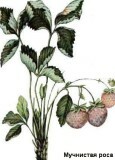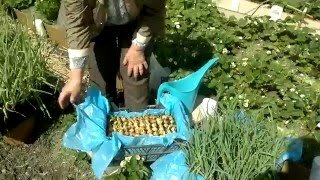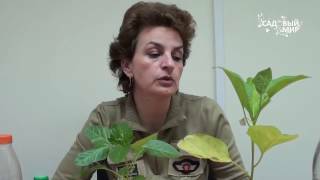Strawberry lovers every spring look forward to a new harvest of these tasty, fragrant berries. But sometimes gardeners are faced with an unpleasant problem: strawberries dry berries. To prevent or remedy such a situation, it is necessary to understand the causes of what is happening.


Insufficient irrigation
Of course, first of all an experienced gardener, having found out that strawberries are drying berries, will check if the plants are well watered. The point is that sufficient moistening of the soil is necessary not only at the time when the berries are only beginning to be poured, but also throughout the entire period of fruiting. Especially if the summer was too hot and dry.
It should be noted that hard work with watering strawberries is also impossible, because the constant humidity promotes the multiplication of many harmful bacteria. Some of them, in turn, cause diseases that also lead to the drying of strawberries.
Fungal diseases
Why does strawberry sometimes dry up, even if it has a sufficient moisture level? Obviously, the point here is not the wrong watering. It should be noted that sometimes fungi can cause some fungal diseases:
- Spotted.
- Gray rot.
- Powdery mildew.
- Verticillium wilt.
- Late blight.

 late blight
late blight
Gray rot
If the ripening strawberry berries are covered with rapidly increasing brown spots, then the plant is most likely affected by gray rot. The sick berries become soft, discolour and lose taste. They rot, and on their surface a thick gray mold-like plaque forms. After some time, mummification of the berries affected by gray rot occurs, the strawberry dries and continues to hang on the bush for a long time.
The causative agent of gray rot is the fungus that lives in the soil. He suffers not only strawberries, but also other plants. If this condition is found, all affected bushes should be removed and burned.


Gray rot is also dangerous because an inexperienced gardener is difficult to recognize when a disease affects plants during the formation of berries. In this case, the green aboveground part of the plants can look quite healthy and juicy, and the fruits will suddenly begin to dry up.
Powdery mildew
Mildew first appears on the reverse side of the leaf, and then gradually spreads throughout the plant - along stems, mustaches and fruits. Strawberries dry and curled edges of the leaves. The leaves themselves harden and stop growing.


Buds, flowers and ovaries seem healthy at first glance, but the powdery mildew on these parts is simply not visible. When flowers appear on the affected strawberry, they can not normally pollinate and fertilize. This leads to underdevelopment and deformation of berries, they dry out and have an unpleasant taste and smell.
It should be noted that powdery mildew is least affected by plants planted on elevations and in suspended pots.
Verticillium wilt
Spores of the fungus Verticillium can live in the soil for 25 years or more, so this disease is considered one of the most dangerous. The appearance of the first symptoms of vertical wilt on young seedlings can be seen during the period of whiskers formation. If the plantations are old, then, as a rule, the disease manifests itself immediately before harvesting begins.


Symptoms may differ depending on how specific a variety is susceptible to the disease. To accurately determine the presence of this disease, it is necessary to do special laboratory tests.
The main sign of infection of plants are drooping, wilted leaves, which acquire a red-yellow or dark-brown color. If the site is seriously affected, then practically all the strawberry bushes wither. In the case when only individual plants are infected, it is necessary to remove them from the garden and burn them.
Phytophthora
This disease is also called skiny rot. Late phytophthora affects negatively the quantity and quality of the crop, and in some cases can lead to its complete loss.


When it is not clear why the strawberry is bitter, you should inspect the bushes for this disease. Bitter berries are a sign that plants are affected by late blight rot.
In addition, a sign of the presence of this fungus are solid spots of brown-lilac color on the surface of ripe fruits. On green berries, late blight rot is deposited in the form of light brown spots framed by a fringe. The affected fetus becomes hard, and then shrinks.
Pests
The cause of shrinkage of strawberry berries may also be insects:
- Stem nematode.
- Strawberry mite.
- Weevil and strawberry weevil.



 weevil
weevil
Nematode
Often the fruits of the strawberry wither because of the plant's damage to the nematode. This disease causes backlog of bushes in growth, thickening and shortening of young leaves. Strawberry leaves wilt, wrinkle and curl into the tube. After a while they are painted in a yellow-brown color. Then follows the deformation of the flowers and the death of the ovary. If the fruits have formed, they do not grow, but dry up.  The fight against the strawberry nematode must be, first of all, preventive. If there is a suspicion of infection of the site with nematodes, then when planting a young strawberry, it is recommended to lower the seedlings for ten minutes in hot( approximately 46 ° C) water. After a hot bath, immediately put the plants in very cold water for 15 minutes. In addition, to prevent pests from entering the bushes, they can be protected with lime: around the seedlings they dig grooves and lime is poured into them.
The fight against the strawberry nematode must be, first of all, preventive. If there is a suspicion of infection of the site with nematodes, then when planting a young strawberry, it is recommended to lower the seedlings for ten minutes in hot( approximately 46 ° C) water. After a hot bath, immediately put the plants in very cold water for 15 minutes. In addition, to prevent pests from entering the bushes, they can be protected with lime: around the seedlings they dig grooves and lime is poured into them.
Strawberry mite
This pest causes significant damage to strawberry plants. First, it damages the leaves, and in autumn the females begin to look for a suitable place for wintering. As a rule, they live in the bases of petioles of leaves, where eggs are laid in early spring. Since the leaves of strawberries at this time have not yet turned around and have not had time to gain strength, the plant begins to ache, resulting in berries becoming dry and very small.


In the absence of measures to control the strawberry mite, it settles around the site and the whole strawberry is killed.
- Control measures against this pest are the same as for the nematodes: the seedlings are lowered into the hot and then into the cold water before planting.
- If in spring it was found that the plants have mites, you should treat the site with a strawberry "Carbophos" or "Gray colloid".In this case, the first treatment should be done in the period when only green leaves appeared, and the second one - before the beginning of flowering of the strawberry.
- If there are a lot of mites in a strawberry, then it is necessary to cut all the plants under the root and burn them.
Strawberry-raspberry weevil
The development time of the larva is one month. Before turning into beetles, larvae feed on the contents of the buds. Young beetles eat the flesh of the leaves. If the area with strawberries is too thick, weevils can destroy the entire crop in one season.
Typically, buds damaged by larvae of buds die after several days after the female laid eggs in them. The surviving flowers give small, dry and unfit for consumption berries.


To protect strawberries from weevils, plants should be treated with insecticides, for example, Inta-vir. If the number of pests is too high, the treatment should be repeated after collecting all the fruits. It should be remembered that strawberries with fruits can not be sprayed with such drugs.
In addition, since insect pests are afraid of the smell of onion and garlic, it is recommended that they alternate strawberries with these plants when planting.
All gardeners need to take a rule for themselves in the spring and autumn to treat strawberries with drugs from pests and diseases, and then you will not have to ask questions, why strawberries disappear and what to do to save it.
Related videos:
 5:36
5:36  8:11
8:11  11:29
11:29 